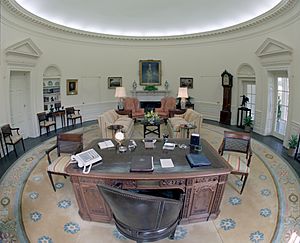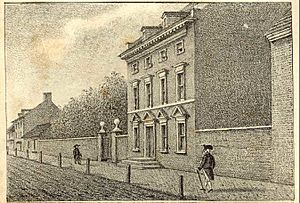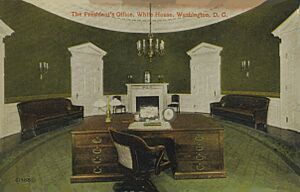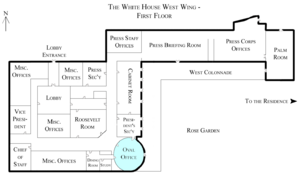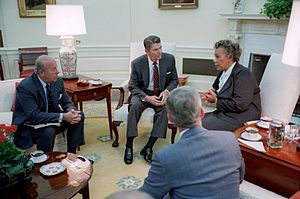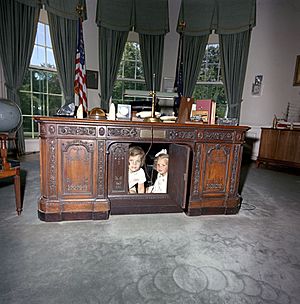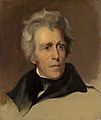Oval Office facts for kids
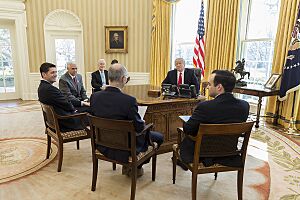
The Oval Office is the special workspace of the President of the United States. It is located in the West Wing of the White House in Washington, D.C.. This famous office has been used by presidents since 1909.
The room has three big windows behind the president's desk. There is also a fireplace. It has four doors. One door leads to the beautiful Rose Garden. Another door goes to a private study and dining room. The other two doors lead to the main hallway of the West Wing and the president's secretary's office.
Presidents often decorate the Oval Office to show their own style. They choose new furniture, curtains, and even design their own oval-shaped carpet. Artwork for the office comes from the White House's collection or is borrowed from museums.
Contents
Why the Oval Office is Famous
The Oval Office is a very important symbol of the presidency. Many memorable moments have happened there. For example, a young John F. Kennedy, Jr. was once seen peeking from under his father's desk. President Richard Nixon called the Apollo 11 astronauts from the office when they were on the Moon.
Presidents also use the Oval Office to talk to the nation. John F. Kennedy announced the Cuban Missile Crisis from there in 1962. Ronald Reagan spoke to the country after the Space Shuttle Challenger disaster in 1986. George W. Bush addressed the nation after the September 11 attacks in 2001.
How the Oval Office Came to Be
The idea of an oval-shaped room for the president goes way back.
George Washington's Special Room
George Washington was the first president, but he never lived in the White House. He spent most of his time in Philadelphia, Pennsylvania. This city was the temporary capital from 1790 to 1800.
In 1790, Washington added a large, round room to the back of the President's House in Philadelphia. This "Bow Window" was a special place where he met with people. He would stand by the windows to greet guests, members of Congress, and foreign leaders.
President John Adams also used this room in the same way.
The White House Oval Rooms
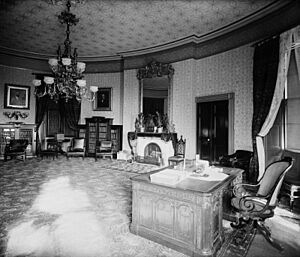
When the White House was designed, architect James Hoban likely saw Washington's round room. Hoban's plan for the White House included an "elliptic salon," which is an oval room. Oval rooms were popular in architecture at that time.
In 1800, John Adams became the first president to live in the White House. He and Thomas Jefferson used the White House's oval rooms for official meetings, just like Washington did.
During the 1800s, some presidents used the Yellow Oval Room on the second floor of the White House as their private office.
The West Wing is Built
The West Wing was built because President Theodore Roosevelt needed more office space. His wife thought the second floor of the White House should only be for living. So, in 1902, Roosevelt moved the president's offices to the new West Wing.
-
The Yellow Oval Room in 1868, used as President Andrew Johnson's library.
The First Oval Office (1909–1933)
President William Howard Taft made the West Wing a permanent building. He made it bigger and added the very first Oval Office in 1909. This office was in the middle of the West Wing. Taft wanted it to be the main place for his work. The walls were a bright seagrass green.
In 1929, during President Herbert Hoover's time, a fire badly damaged the West Wing. Hoover used this chance to add more offices. He rebuilt the Oval Office, making it even better. He also added air-conditioning and new furniture.
The Modern Oval Office (1934–Present)
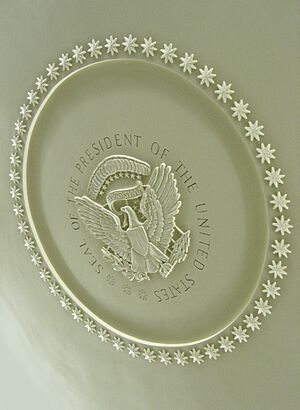
President Franklin D. Roosevelt (FDR) wanted a better West Wing. In 1933, he hired architect Eric Gugler to redesign it. Gugler added a full basement and more offices. He also expanded the building to create a new, larger Oval Office.
The modern Oval Office was built in the southeast corner of the West Wing. This gave FDR, who used a wheelchair, more privacy and easier access. FDR and Gugler designed a grander room with strong details. The ceiling has a medallion of the Presidential Seal. Instead of a chandelier, lights hidden in the ceiling make the room bright.
FDR and Gugler worked closely on the design. One idea they had was to place two high-backed chairs in front of the fireplace. This allowed FDR to sit at the same level as his guests, which was helpful since he couldn't stand easily. The modern Oval Office was finished in 1934.
Decorating the Office
The Oval Office usually has a desk, chairs by the fireplace, sofas, and tables. The fireplace mantel was saved from the first Oval Office after the 1929 fire. Since John F. Kennedy's time, potted Swedish ivy plants have been placed on the mantel.
A tall clock, made around 1795, has been in the Oval Office since 1975.
The carpet in the Oval Office has the Presidential Seal. President Harry S. Truman was the first to have a carpet with the seal. Most presidents now design their own rug. When a president leaves office, their carpet often goes to their presidential library.
Presidential Desks
Six different desks have been used in the Oval Office. The Theodore Roosevelt desk was used by seven presidents.
The most famous desk is the Resolute Desk. It was made from the wood of a British ship called HMS Resolute. This ship got stuck in Arctic ice but was later found. It was fixed up and given as a gift to Queen Victoria in 1856. When the ship was taken out of service, Queen Victoria had two desks made from its wood. She kept one and gave the other to President Rutherford B. Hayes in 1880.
President Franklin D. Roosevelt added a panel with the Presidential Seal to the desk. First Lady Jacqueline Kennedy had the desk restored and was the first to put it in the Oval Office. After President John F. Kennedy was assassinated, the desk traveled around the country. President Jimmy Carter brought it back to the Oval Office in the 1970s. Since then, many presidents, including Ronald Reagan, Bill Clinton, George W. Bush, Barack Obama, and Donald Trump, have used the Resolute Desk.
When a desk is not in the Oval Office, it might be in the nearby study or used by the vice-president.
Art in the Office
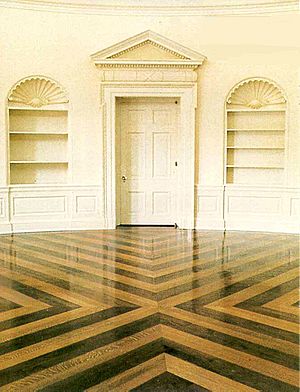
Presidents choose artwork from the White House collection or borrow it from museums.
Most presidents hang a portrait of George Washington above the fireplace. Portraits of Andrew Jackson and Abraham Lincoln have also been popular. Many presidents have displayed sculptures, busts, and figurines. Lincoln is a common subject for these.
Western sculptures by Frederic Remington, like The Bronco Buster, have been displayed by many presidents.
Presidents often choose art that reflects their interests or home states. For example, President Harry S. Truman displayed art about Missouri. President John F. Kennedy had paintings of naval battles. President Richard Nixon hung a famous photo of Earth taken from the moon, called Earthrise.
After the September 11 attacks, British Prime Minister Tony Blair lent President George W. Bush a bust of Winston Churchill. President Barack Obama honored Abraham Lincoln and Martin Luther King Jr. with portraits and busts.
Changing the Look
It became a tradition for each new president to redecorate the Oval Office. A new administration usually picks a new carpet, new curtains, and new paintings. The First Lady often helps with this redecoration.
Small Changes Over Time
The Oval Office has mostly stayed the same since it was built in 1934. However, some small changes have been made. Doors and window frames have been adjusted. President Lyndon B. Johnson added special wiring for his Teletype machines.
The floor of the Oval Office has been replaced four times. The first floor was made of cork. President Dwight D. Eisenhower damaged it with his golf spikes! In the 1960s, Johnson replaced it with linoleum. In 1982, Ronald Reagan had a new wood floor installed. President George W. Bush replaced the floor again in 2005, keeping the same wood pattern.
Images for kids
-
The Oval Office floor, replaced during the administration of George W. Bush.
-
George Washington (1776) by Charles Willson Peale.
-
George Washington (c.1823) by Rembrandt Peale.
-
Andrew Jackson (1845) by Thomas Sully.
-
Waiting for the Hour (1863) by William Tolman Carlton.
-
The Broncho Buster (1895) by Frederic Remington.
-
Franklin D. Roosevelt (1947) by Frank O. Salisbury.
-
Earthrise (1968) by William Anders.
See also
 In Spanish: Oficina Oval para niños
In Spanish: Oficina Oval para niños


